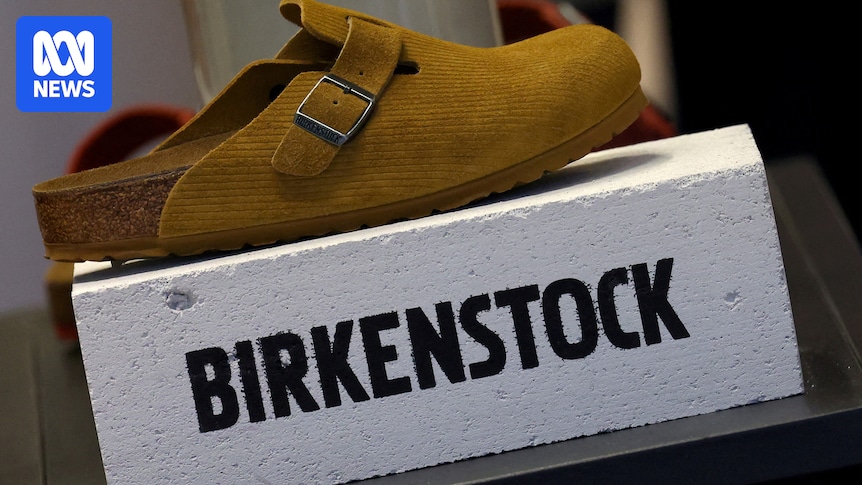Australian shoppers could soon see higher price tags, as some brands affected by Donald Trump’s trade war prepare to increase prices beyond the US market.
German shoe manufacturer Birkenstock is among the global retailers set to raise prices across the board to spread out the cost of tariffs.
Birkenstock’s chief financial officer Ivica Krolo told an investor briefing this month that spreading the cost would mean modest price rises across the board, rather than a big hike in the cost for US purchasers.
“For a full offset of tariff impact, we would need only a low single digit price increase globally.”
Mr Krolo added that, “pricing is not the only lever we have though … additional levers include efficiencies in production, vendor negotiations, the optimisation of product mix and the allocation of products between the different regions.”
Pandora estimates that US tariffs could add tens of millions dollars to its cost. (Reuters: Hollie Adams)
One of the world’s biggest jewellery brands, Pandora, is also eyeing price rises. It primarily produces its products in Thailand.
The Danish jeweller outlined the scenarios of tens of millions of dollars in cost increases due to US tariffs in its first-quarter interim financial report, saying: “the extent and timing of further price increases to be determined based on the concrete circumstances.”
Fashion brands want to bring manufacturing home
Meanwhile, analysts are closely monitoring the outlook for Apple and Samsung, given Mr Trump has threatened a 25 per cent tariff on smartphones not made in America.
“If iPhones got built in the US, you’d be looking at iPhones in Australia that go up three times from where they are today,” Wedbush Securities analyst Dan Ives told The Business from New York.
“It’s not just about the US consumer, it’s about the foundation of all the costs that are increasing around the world.”
Stephen Halmarick is the principal at Economics Unchained and the former chief economist at the Commonwealth Bank. (ABC News: Daniel Irvine)
Economists say the rationale for multinational firms to spread the cost beyond the US is to avoid dampening demand from American consumers, which is a large and crucial market, by having them foot the bill entirely.
“If they impose all of the price increase on the US consumer, that could do a number of things, which is reduce demand significantly by the US consumer,” former Commonwealth Bank chief economist Stephen Halmarick told The Business.
“It could also bring them some unwanted attention from the [US] president, I would say,”
the now-principal at Economics Unchained noted.
The impact could be felt around the world in a matter of weeks and months.
“As we get into June, July, August, you’re going to see price increases around the world,” Mr Ives said.
“You could see prices increase anywhere from 3 to 5 per cent, and then some products potentially double digits.”
Growth worries overshadowing inflation risk
When the Reserve Bank board cut interest rates in May, it highlighted the risk to the global economic growth outlook posed by the trade war.
It also emphasised that local inflation pressures had eased, and inflation was “expected to remain around target”, opening the door to further rate cuts.
Micaela Fuchila is the chief economist at Jarden. (ABC News: John Gunn)
“We see two more cuts, one in August and one in November,” Jarden chief economist Micaela Fuchila said.
“We have inflation under control, the labour market is in a good place, and there are some signs that the economy is recovering.”
The hidden factor that may limit rate cuts
Despite the focus on the downside risk to global growth, the RBA has acknowledged the potential for global price hikes — although deputy governor Andrew Hauser doubts the longevity of the strategy.
“Trying to insulate your US demand by putting prices up in other markets might be self-defeating because you might just end up killing your demand everywhere,”
he said.
Steve Tsonidis is the general manager at ABMT Textiles. (ABC News: Richard Sydenham)
In Melbourne, this fabric manufacturer shares similar concerns.
“The biggest worry for me is higher pricing will mean less demand, which means less requirements for product, which will definitely impact on future projections and buying,” Steve Tsonidis, the general manager at ABMT Textiles, told The Business.
ABMT exports a third of its products to the US, with fabric produced here and garments made in Vietnam and Bangladesh.
“It’s very hard to plan at the moment because the goalposts are moving so much … everyone’s scrambling to see what they can do to get around the tariff situation.”
The RBA’s base case is that the trade war will put downward pressure on inflation here, but it has considered scenarios where prices could rise.
“There are possibilities that if this goes far enough and it impairs global supply chains, that could push inflation up here and everywhere else for a period,” Mr Hauser said.
The RBA board next meets in early July, just before the pause on the US “reciprocal” tariffs affecting more than 50 nations is due to expire.
